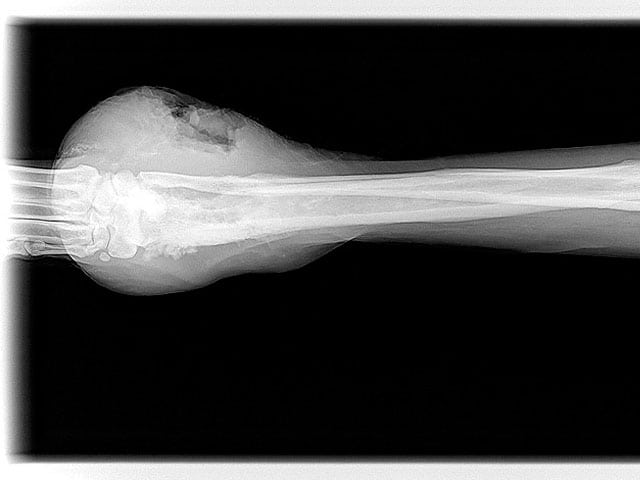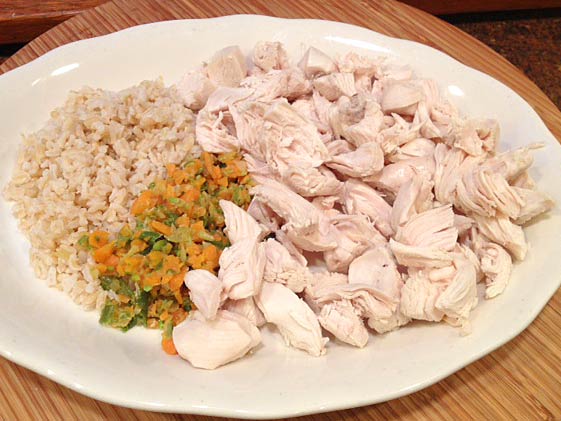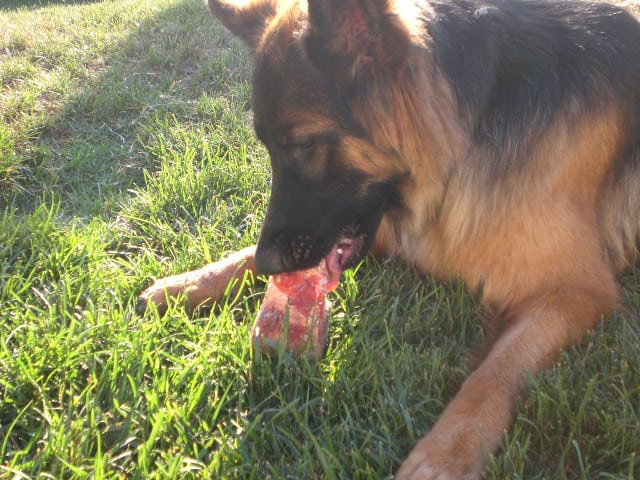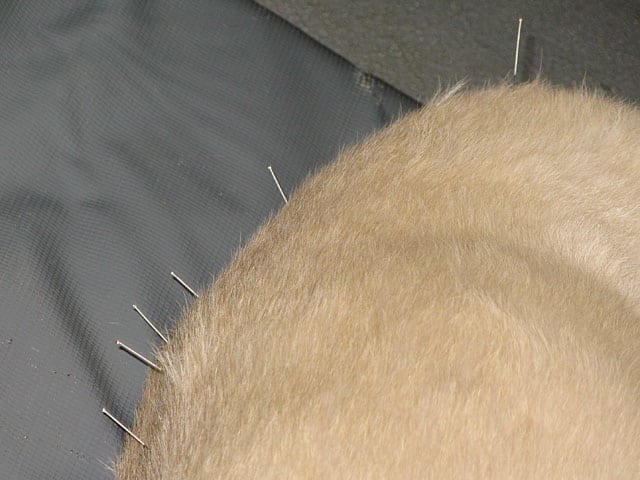Holistic cancer therapy for dogs and cats is a popular option for many pet pawrents, and the more you can educate yourself about your treatment options the better off you (and your wallet!) will be when fighting cancer.
 In the spirit of education and self-empowerment, Tripawds member Michelle (aka Sassy Sugar Bear) generously contributed the following article about a holistic cancer care seminar she attended last July.
In the spirit of education and self-empowerment, Tripawds member Michelle (aka Sassy Sugar Bear) generously contributed the following article about a holistic cancer care seminar she attended last July.
We hope you find the information as informative as we do, but please remember this information is not meant to replace your veterinarian; always discuss any treatments, supplements or other cancer care therapies you’d like to try with your own veterinary professional.
Non-Toxic Cancer Therapy Overview
by Michelle Doner
I attended a seminar on July 30, 2013 on Non-Toxic Cancer Therapies given by Dr. Jennifer Hebel of 5 Elements Veterinary Alternatives in Omaha, Nebraska. Dr. Hebel has an integrative approach to cancers. She uses holistic treatments, acupuncture, chiropractic care & physical rehabilitation.
 Dr Hebel provided a lot of great information listing some of the most common cancers in dogs:
Dr Hebel provided a lot of great information listing some of the most common cancers in dogs:
- Lymphoma
- Cutaneous Mast Cell Tumors
- Hemangioscaroma
- Osteoscaroma
- Melanomas
- Mammary Cancers
The body’s immune system normally destroys abnormal cells. Cancer is simply (figuratively speaking) part of a dog (or cat’s) body that has gone awry and has escaped the normal removal by the immune system.
Dr. Hebel’s main objective in her treatment is to strengthen the immune system to at least hold the cancer at bay or eliminate the cancer if possible. One thing that she couldn’t stress enough was
“Cancer should not define our Dog or Cat”
Meaning they are still our babies. Not “a cancer dog.” Many times people see their pets as a “Big Tumor.” We should continue as we would normally treat them, like they don’t have cancer.
This seminar didn’t really touch on the conventional treatments of cancer but did list them off: Surgical removal, chemotherapy IV & oral, Radiation (Dr. Hebel mentioned there are a lot of side effects with this) as well as a Cancer Vaccine that has just started being used for Stage II & Stage III melanomas after cancer removal.
The Nutritional Approach to Cancer Treatment
 Dr. Hebel stated there is no “perfect diet for cancer.” However no herb, supplement etc. makes up for diet or can be considered food. We need a diet that is palatable. Dogs who don’t want to eat are often considered with anorexia. Anorexia is often due to an aversion to the taste of food. High digestibility food which can be canned, raw or homemade meals can help to minimize the effects of Anorexia.
Dr. Hebel stated there is no “perfect diet for cancer.” However no herb, supplement etc. makes up for diet or can be considered food. We need a diet that is palatable. Dogs who don’t want to eat are often considered with anorexia. Anorexia is often due to an aversion to the taste of food. High digestibility food which can be canned, raw or homemade meals can help to minimize the effects of Anorexia.
Moderate proteins/fats and reduced carbs are foods that we want to feed. Cancer cells use carbs, not fat, for energy — which is why we would like to have a lower carb diet. Not all carbs are bad though, just ones that are high in glycemic index such as: bread, potatoes, stuffing, foods that have fructose, sucrose & lactose or your simple carbohydrates.
Good sources of carbohydrates are your steel cut oats, buckwheat, millet & quinoa.
Thermal Properties of Food
There are also thermal properties of good to be considered, based on the type of cancer. There are “Warm” versus “Cool” diets. This is the part I found really interesting.
Some of the foods that are considered hot/warm :
- Proteins: Chicken, venison , lamb, pheasant.
- Grains/starch: oats, white rice, sweet potatoes
Foods considered Cold or cool foods:
- Proteins: Duck, turkey, Cod (or your white fish), Rabbit
- Grains/Starch: Millet, Barley & brown rice
Dr. Hebel mentioned Dr. Ogilvie’s Diet as a good diet to follow. She listed the cancers according to their thermal properties, such as Hot Cancers: Which make the dog internally hot?
- Ostescaroma
- Bladder Cancers
- Fibroscaromas
 The objective to treat with a hot cancer is to:
The objective to treat with a hot cancer is to:
- Clear the heat
- Raw diets may be ok to do this
- Use up to 25% of leafy greens in the diet
- Feed white fish, turkey, rabbit, sardines,
- Barley & winter squash are also some foods that can be fed
Blood deficient cancers are your cool cancers. Examples are
- Mast Cell Tumors
- Lymphomas
- Hemangioscaromas
Dogs with cool cancers are usually really dry and have to replenish moisture & build blood. Treatment examples include feeding food rich in colors such as:
- Beef Liver
- Sardines
- Eggs
- Dark leafy greens
- Broccoli
- Lycium Berries
- Raspberries, Blueberries
- Beets & Adzuki Beans
What About the Anorexic Dog?
Feeding strategies are a big important part of any dog or cat with cancer, especially the anorexic dog. One important thing is the DESIRE to eat. Meaning, if the dog or cat sniff the food at least they have the desire, to eat but it’s not palliative to them. The animal may need:
- Anti-nausea meds
- Stomach Protectants (acid reducers)
Always keep a variety of commercial & “human” food options at all times for your babies
If the dog/cat eats the food once, don’t feed it again for several days. Over feeding the item can turn them completely off of food.
For example Dr. Hebel had a patient who would eat deli roast beef. The pawrents fed it to their dog multiple days in a row then he wouldn’t eat it again. nor would he eat anything for a few days.
The Final step is force feeding/or feeding tube if the anorexic dog doesn’t eat.
Anti-Cancer Supplements
 Dr. Hebel also covered other supplements very briefly.
Dr. Hebel also covered other supplements very briefly.
Several immune stimulants she did mention were :
- Echinacea purpurea (Western Herb)
- Astragalus
Herbs that have an anti-tumor property:
- Cats Claw
- Reishi & Maitaki mushrooms
- Pau D’Arco(South American Tree Bark)
Chinese Herbs for fighting cancer include:
- Nei Xia Wan (Stasis Breaker)
- Si Junz Tang (Wei Qi Boost)
Dr Hebel just briefly mentioned these and did not mention dosage amounts or other uses for these herbs than the anti-tumor usage.
Holistic Pain Relief
 Acupuncture: Can relieve pain associated with or without cancer. It does induce the release of serotonin & endorphins in the body. It can help improve energy level & quality of life. It may involve “dry” needles or electrical stimulation.
Acupuncture: Can relieve pain associated with or without cancer. It does induce the release of serotonin & endorphins in the body. It can help improve energy level & quality of life. It may involve “dry” needles or electrical stimulation.
The power of Healing touch is important too. Other modalities such as homeopathy, chiropractic, Reiki, etc. may improve quality of life as well.
Finally, she said the MOST important thing is POSITIVE mental attitude on part of the owner and entire family will help the patient.
These were some of the things we discussed. We did not get into specifics of treatments and these are the notes that I took at this seminar as I am no vet please discuss your options & treatment plans with your vet.
Recommended Reading:
Four Paws, Five Directions Deciphers Veterinary Chinese Medicine
DISCLAIMER: The information contained here is intended as education/information only. It is not intended to replace your veterinarian. Please use your own good judgment and always discuss any dietary changes for your pet with your veterinary team.


Thanks, Michelle! Great wrap up and overview. Sassy was a lucky lady to have a mom like you!
~ Katy & Jackson
A whole lot of effort went into gathering all this great information! Thank you so much for sharing.!
I found the cold food/hot food really interesring.
But o e lf the best parts of the article…..seeing that pretty Sassy Sugar Bear!! She’s so beautiful!
Thanks Sassy, for continuing to make a differemce in all our lives!
Gratefully,
Sally and Happy Hannah
Thanks for sharing. I started my lab, Dino, on Dr. Ogilvie’s diet. He just completed his third chemo Rx. No signs of spreading lesions yet! Patti and Dino
Keep on rockin’ Dino! You have a pawesome pawrent!!!